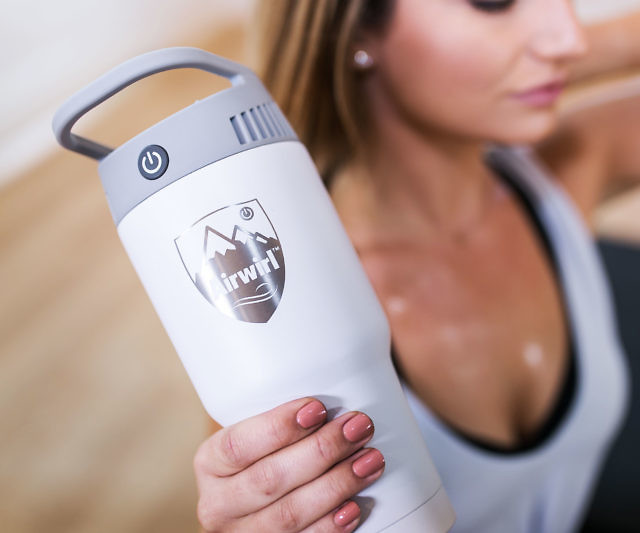- PhentermineLearn more about phentermine and how to get the most from your weight loss journey.
- ResourcesAdditional information and tools to help you make the most of your effort.
- AlternativesLearn more about the most popular weight loss medications and science-backed supplements
Can Cooling your Hands Help Make Exercise Longer and Improve Your Strength? Read Here!
Published on December 12, 2024

Chill hands help you nail your job as the sun turns up the heat. Elevate your performance by keeping those palms cool.
Our hands may have significantly impacted our evolution more than the human brain. As Alan Ruddock demonstrates, keeping your hands at a cool temperature can help you perform better in sports (1).
The development of human hands can be traced back to the usage of tools by apes millions of years ago. The most effective monkeys developed a “precise grasp” for throwing and a “power grip” for clubbing (1).
Our ancestors employed these new means of battle and hunting to generate anatomically superior individuals in our species through a process known as “survival of the fittest” over millions of years (1).
In the previous few thousand years, our hands have changed substantially to incorporate many new features, including our thumbs and the first two fingers of our ape cousins. Increased strength, flexibility, agility, and precise neuromotor control in our fingers are only some of the benefits. However, our hands are a vital component when it comes to heat exchange and core body temperature (1).
Hands and temperature regulation
Because of its sizable surface-to-mass ratio, low metabolic heat production, abundant blood supply, and rapid cooling rates, the human hand is an excellent example of an efficient design for heat exchange (gain and loss). The blood arteries of the hand are sensitive to temperature and other environmental conditions (2).
When it’s cold outside, the blood arteries near your skin’s surface constrict, sending more of your body’s warm blood to the organs most vital to your survival. However, blood flow to the skin increases as your core temperature rises. This, in conjunction with sweat, makes it easier for you to cool down (2).
To chill one’s hands, the United Kingdom’s Royal Navy came up with the concept of hand cooling in the late 1990s. Researchers from the United States Navy completed the first study to lessen heat strain by swiftly submerging hands in cool water after exercising at temperatures of 40 degrees Celsius while wearing full firefighting gear. It was up to them to decide whether or not they wanted to unwind by soaking their hands in water that was either 10 degrees Celsius, 20 degrees Celsius, or 30 degrees Celsius warm (2).
According to the data, the cooling process went faster in water with a lower temperature. Core temperatures dropped from 38.5 degrees Celsius to 36.9 degrees Celsius after 20 minutes of recovery in water at 10 degrees Celsius and from 37.3 degrees Celsius to 37.8.8 degrees Celsius in water at 20 degrees Celsius, respectively. The fundamental strategy that the authors described could be helpful in a wide variety of commercial and military endeavors requiring extended work periods followed by rest (2).
Throughout their careers, athletes frequently have to find a balance between competing and resting. After completing a 60-minute workout, the researchers immersed their hands in water chilled to a temperature of 10 degrees Celsius for ten minutes to test how it would affect their performance in subsequent high-intensity time trials based on military research (2).
The non-disabled athletes competed in a time trial that was three kilometers long, while the impaired athletes in wheelchairs competed in a time trial that was one kilometer long. According to the findings, the use of hand cooling shaved off roughly 20 seconds from the 1-kilometer time trial and 14 seconds from the 3-kilometer time trial (2).
It has been determined that the elite wheelchair athletes and the mechanics of the wheelchairs were responsible for a far more significant improvement in the one-kilometer time trial than would have been possible without them (2).
Regarding thermoregulation, athletes who aren’t allowed to get enough rest or forced to wear protective gear may be at a disadvantage. To put it another way, hand immersion is a cause for concern since it makes it more difficult for a person to perform tasks requiring using their hands. Researchers from the United Kingdom devised a solution to these issues by developing water-perfused forearm cuffs that circulated water at a temperature of 12 degrees Celsius (2).
Participants in this study were asked to undertake box stepping exercises in temperatures as high as 40 degrees Celsius until their core temperatures reached 38.5 degrees Celsius. When no cooling was applied, it took 34 minutes to reach a core temperature of 38.5 degrees Celsius, but when the cuffs were worn, it took 47 minutes to reach the same temperature (2).
The following step involved them relaxing for forty minutes in the exact location while researchers recorded their core temperature responses to various stimuli. Some of the participants decided to remain restrained in their handcuffs for the duration of the break period of forty minutes. The most significant reduction in core temperature was achieved with hand immersion, which is consistent with the earlier study’s findings (2).
After 10 minutes of using the water-perfused cuff and receiving no therapy, the core temperature dropped by an average of 0.8 degrees Celsius. Both the cuff and the control conditions were unable to bring the core temperature down below 38 degrees Celsius, and this was the case even after 40 minutes of data collection, even though the core temperature had returned to levels associated with resting after only 30 minutes of data collection (between 37 and 37.5 degrees Celsius) (2).
According to the study’s authors, cooling the forearm is an effective strategy for minimizing heat strain during exercise; nevertheless, hand immersion should be the form of cooling favored for use while the body is at rest (2).
Vasodilation produced by cold
Have you ever been outside in the cold and observed that your hands start to warm? As you make your way to work on a chilly winter morning, you notice that your hands are becoming smaller due to the cold. However, after a few minutes of use, you’ll see that your hands begin to warm up oppositely from what you anticipated. This will be the case if you keep using the gloves (3).
The ‘hunting response,’ also referred to as ‘cold-induced vasodilation,’ is a natural reaction that guards your hands against injuries caused by the cold (damage to finger cells). Coaches and athletes can use this response to speed up and improve the effectiveness of cooling down the rest of the body (3).
It’s probably safe to say that the cooling systems in our bodies were designed to protect us from heat stroke. They were forced to endure long journeys under the scorching sun to find food for our ancestors, who were hunters and gatherers. Because of this, the central cooling systems of our bodies, such as the diversion of blood from the core to the periphery and the sweat responses that promote convection and evaporation, have developed for usage in hot weather (3).
Cooling by vacuum
If heat loss occurs due to peripheral circulation, then the amount of blood pumped to the body’s extremities may impact how rapidly the body cools down. Researchers at Stanford University in the United States deployed a low-pressure vacuum to attract blood to the region to increase blood flow to the hand (4).
This was done to treat patients who had poor circulation in their hands. In addition, a metal surface was kept at 18-22 degrees Celsius so that writing could be done at a comfortable temperature (4).
Participants were given the directive to keep going until they hit 90 percent of their maximal heart rate while climbing an elevation at a speed of 5.63 kilometers per hour at a temperature of 40 degrees Celsius. This was to be accomplished at a temperature of 40 degrees Celsius (MHR). It was investigated in each of the following three settings (4).
There is no cooling; the only techniques available are supplemental vacuum cooling and hand cooling. According to the study’s findings, Condition #2 had a minimal effect on the total amount of time spent exercising, accounting for up to 90 percent of MHR (an increase from 34 to 38 minutes) (4).
In contrast, the average time required to acquire 90 percent of MHR was 57 minutes. If the vacuum situation causes the blood vessels to remain open for more extended periods and more consistently, then the heat extraction rate will be more significant than it would be in any other way (4).
The results of the second test, carried out in the heat and utilizing the same apparatus as the first, were comparable to those of the first investigation. The men who used the cooling device finished a 30-kilometer trial in temperatures of 32 degrees Celsius, 6 percent faster than the other men who did not utilize the cooling equipment (4).
Takeaway
Most significant championships are held during the summer, reducing the possibility of heat exhaustion. Keeping an athlete’s core temperature from rising too high is critical to their health and performance. Keeping your hands cold can help prevent heat stroke and increase performance, so here are several strategies you can use to accomplish both goals (5).
The vacuum hand cooling apparatus mentioned in this article has a price tag of 1,400 pounds. Water-perfused forearm cuffs are probably not a viable solution in sports, even though they appear to be effective. Immersion of the hands in cooled water, on the other hand, does not need the use of any special equipment and may be carried out virtually anywhere (5).
The lower the temperature must be for heat to be taken from the water at a faster rate; conversely, the quicker heat can be removed from the water, the higher the temperature. The body’s core temperature can be lowered and heat removed from the body most effectively when the water temperature is 10 degrees Celsius (5).
It has been discovered that the core temperature can be lowered by around 1 degree Celsius after ten minutes of hand immersion in water that is 15 degrees Celsius. By reducing the temperature of the water, it is possible to accelerate the pace at which heat is removed (5).
If you are participating in an intermittent sport such as football, rugby, or hockey, the optimal time to hand-cool your hands are during the halftime break. During this period, lowering your core temperature by 0.5 degrees Celsius from 15 degrees Celsius in water will help increase your performance and lessen the risk of heat illness (5).
In the case of endurance sports such as running and cycling, pre-cooling with hand cooling before an event would enable the body to store more heat before reaching dangerously high core temperatures. A potential benefit of this is that athletes may be able to exert themselves more vigorously before their body’s capacity to maintain heat is compromised (5).
Our hands are essential to our lives for various reasons beyond only operating multiple pieces of machinery. Because of their large surface area, our hands serve as major thermal exchange points and can help the entire body cool down more quickly. This is because of the way their blood vessels are structured (5).
Studies have indicated that exposing one’s hands too cold temperatures of 15 degrees Celsius for ten minutes as part of a recovery or performance regimen can lower core temperature and boost recovery. Even while additional vacuum cooling may bring considerable benefits in terms of cooling, the most convenient method of hand cooling for the vast majority of athletes is simply to immerse their hands in cold water (5).
References:
- https://www.washingtonian.com/2012/03/15/how-cooling-your-hands-can-make-a-workout-last-longer/
- https://www.eurekalert.org/news-releases/535784
- https://www.webmd.com/fitness-exercise/news/20120313/cool-hands-may-help-people-exercise-longer
- https://www.sportsperformancebulletin.com/endurance-training/techniques/physiology-sport-keeping-hands-cool-can-help-performance/
- https://pubmed.ncbi.nlm.nih.gov/27494595/


